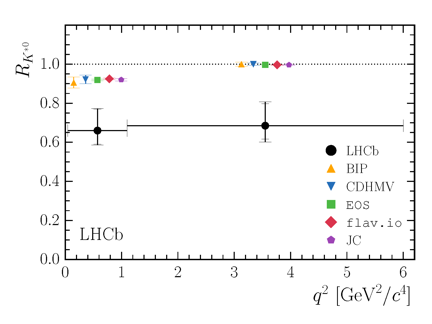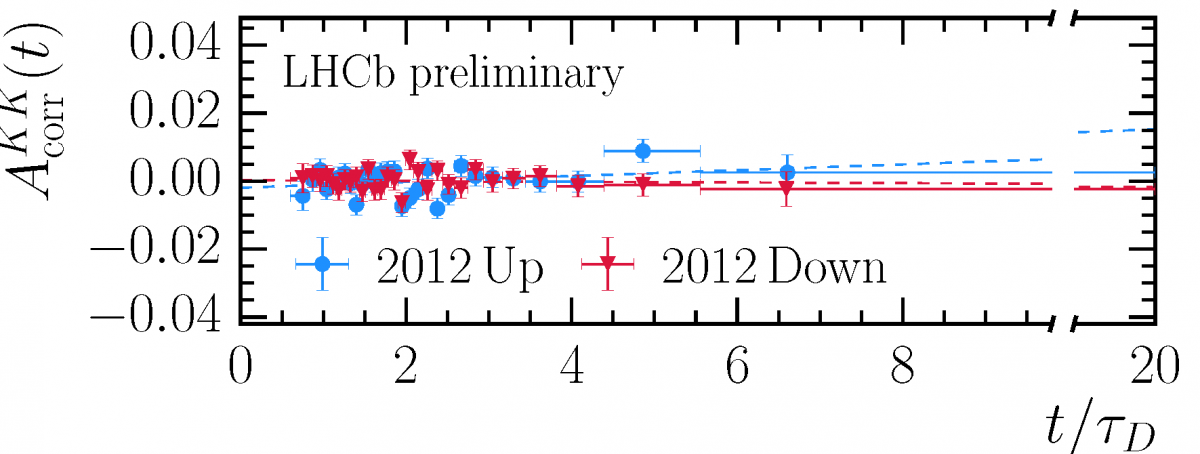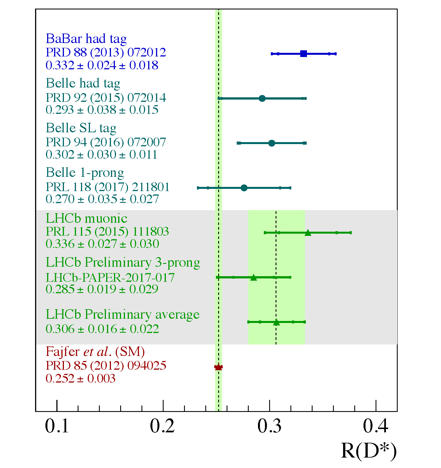LHCb finds new hints of possible deviations from the Standard Model
Last month, the LHCb collaboration presented results on the measurement of RK*0, which is the ratio of the probabilities that a B0 meson decays to an excited kaon and muons (K*0μ+μ-) or electrons (K*0e+e-). By isolating and counting these decays, the LHCb experiment has tested a key assumption of the Standard Model – lepton universality, the idea that electrons, muons and tau leptons should behave in the same way, and be produced equally often in weak decays.
The K*0 meson was reconstructed through its decay into a charged kaon K+ and a pion π-. This measurement provides an important test of lepton universality (LU), which is one of the most important ingredients of the Standard Model of particle physics. Lepton universality means that leptons (e.g., electrons e and muons μ) behave in the same way and have the same couplings to gauge bosons.
Therefore, if lepton universality is valid, RK*0 is expected to be close to unity (small, well-understood effects related to the masses of the leptons prevent the parameter from being exactly this value). Any deviation between the decay rates could be a hint of new physics lying beyond the Standard Model (BSM).
In the LHCb measurement, the measured result is found to be lower than the SM prediction, at the level of 2.1 to 2.5 standard deviations in each of the two regions of q2 (the μ+μ- or e+e- invariant mass squared) in which the measurement is performed.

The above plot shows the measured value of RK*0 in two regions ([0.045, 1.1], [1.1, 6.0] GeV2/c4) of the μ+μ- or e+e- invariant mass squared, q2. A difference from the SM of 2.1-2.3 standard deviations is observed in the low-q2 region and of 2.4-2.5 in the high-q2 interval. These differences are not yet at the level where they can be claimed to exhibit evidence for BSM physics, but they are intriguing when considered in the context of an earlier LHCb analysis. The RK*0 and RK measurements were obtained using the entire Run 1 data sample, corresponding to an integrated luminosity of 3fb-1 at the LHC centre-of-mass energies of 7 TeV.
More recently, the collaboration also presented results of a new measurement of the ratio of branching fractions R (D*) = BF (B0→ D*-τ+ντ)/BF(B0 → D*-μ+νμ). It is the first time that R(D*) had been measured with these three charged pion decay modes of the τ lepton. This has been possible because of the unique capabilities of LHCb in precisely reconstructing decay vertices.
This measurement is affected by different sources of systematic uncertainties, with respect to previously existing analyses and opens a new avenue to precision studies in the sector of lepton universality with τ leptons. An average of this measurement with a previous LHCb measurement using muonic τ decays (τ-→μ-νμντ) gives R(D*) = 0.306±0.016±0.022, which is consistent with the world average and differs by 2.1 standard deviations from the SM prediction.
What kind of BSM physics could explain the LHCb results? Examples are shown in the Feynman diagrams below. The upper ones show the Standard Model contributions. The lower-left one shows a possible contribution from a heavy Z-boson-like particle, named Z prime (Z'), which would interact differently with muons and electrons. The lower-right diagram shows a possible contribution from a hypothetical scalar leptoquark, which would interact with both quarks and leptons. Alternatively, different, not yet predicted, and therefore even more interesting, new physics lying beyond the Standard Model could be at play!

The image below shows a comparison of different measurements of R(D*). It is interesting to notice that different experiments studying either proton-proton (LHCb) or electron-positron (BaBar, Belle) colliders, using very different experimental techniques, measure values systematically above the SM prediction. The average of all results is brought, by including this new measurement, a little bit closer to the SM prediction and at the same time, due to improved precision, the discrepancy between the experimental world average and the SM prediction increases slightly to 3.4 standard deviations.

Any measurement exhibiting a conclusive breakdown of lepton universality, after mass related effects are accounted for, would be a clear sign of new physics.
Data collected in Run 2 has already provided a sample twice as large and it will be of great importance to see whether updates of the present analysis will confirm the discrepancy. The LHCb collaboration has a wide programme of lepton universality tests based on different R measurements in which other particles replace the K*0 or K+ mesons in the ratios. Future LHCb measurements will be able to elucidate whether these tantalising hints are a manifestation of statistical fluctuations or whether LHCb is observing a glimpse of new physics.
More information can be found in the LHCb paper.
